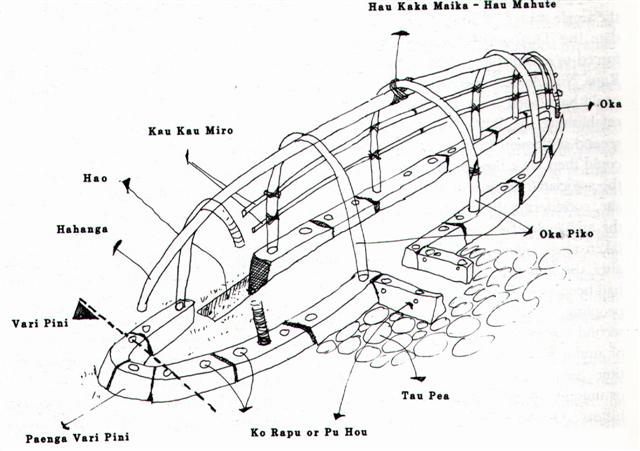2. It seems necessary to use the Polynesian text of Manuscript E in order to have a chance of comprehending, not only the stories in the manuscript but also the rongorongo texts. The canoe made a sweep (he oho te vaka he vari) in order to reach Hanga Te Pau.
A curve is necessary when one season changes into another - as when one limb is joined to the next by an elbow or a knee - and vari is a word which was used in connection with one of the curves in the hare paega:
A dotted line in the picture indicates Vari Pini as a corner of the house, a region not far from the 'exit hole', i.e. the exit from the night side (hare paega) to the outside (haho):
Hao at the exit hole could be a wordplay involving hoa (to make an opening). After a rent (hoa) in the dark cloth of winter has been triumphantly proved by the first manu tara egg in the hand of the bird master (hoa manu) the summer 'year' has arrived. I.e., Sun has made his exit from the hare paega of 'night', having emerged from its hao hole.
The 3 holes (stars?) of Vari Pini are located to the left of the entrance into the house. In the night the flow of time can in a way be regarded as moving from Nga Kope Ririva along the southern coastline, following the path of Moon (who apparently moves from west to east because she moves slower than Earth rotates). To go in the contrary direction, clockwise, would then mean to move against Moon time. In space Moon moves from left to right (if we keep our faces towards the equator), but Sun moves from right to left. This contrary direction in space could have some kind of reflection in the maps of time, and going to the left from the entrance of the house could therefore be a sign of Sun (because in the house of Moon everything is contrary to the world outside). However, in the night we should not have our faces towards the equator, instead we should face in the opposite direcetion, to the south (toga). Moon will then be perceived to move from right to left, exactly as when Sun moves from right to left during the day. Likewise, if we are inside a hare paega then the movement from the entrance to Vari Pini will be towards right. Therefore the first 7 paega stones - where the 5th of them is in the middle of the Vari Pini section - could correspond to the path of Sun on the outside. His path is incorporated, so to say, as a part of the night path inside the house. We should remember how in the Hawaiian calendar 'ebb' was used as a Sign for 'land' (growth, waxing):
After 13 holes there is a trench, 'a hole of exit', at the end of Waxing (cfr 14 Akua). Then should follow 3 more in order to reach 16, and possibly we ought to count the exit hole as one of them. If so, then the holes beyond the exit hole will correspond to numbers 17-35 (and the entrance could be number 36). I perceive that hole number 17 and forwards are depicted smaller than those preceding. The stones (paega) of these 13 holes are 6 in number, quite consistent with measuring half a year of 'Spring Sun' (maybe as 6 * 30 = 180 days). To reach the perfect number 8 (240 days) we must add the trench hole and the following stone, and beyond we can see that the holes are smaller, distributed in 10 further stones. |
